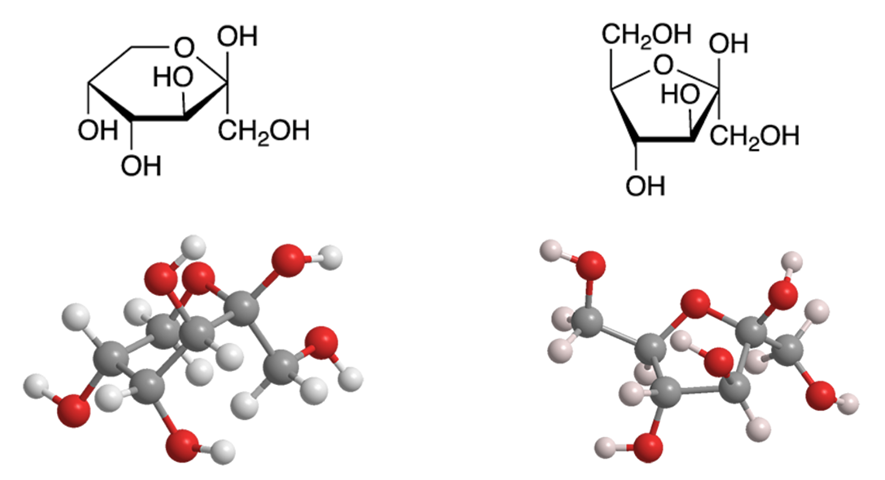What molecule am I?

Fructose, or “fruit sugar”, is one of the three most common natural monosaccharides. (The other two are glucose and galactose.) As its name implies, fructose is found in almost all fruits; but it also exists in commercial quantities in sugarcane, sugarbeets, and corn. Fructose and glucose combine to form the disaccharide sucrose, which we know as common sugar.
The structure of fructose, like all simple sugars, can be expressed as a six-carbon linear chain with hydroxyl and carbonyl groups. In its crystalline form and in solution, however, most of it exists as two hemiketal rings: β-D-fructopyranose1 (left) and β-D-fructofuranose1 (right). In aqueous solution, it consists of 70% pyranose, 22% furanose, and smaller amounts of the linear and other cyclic forms.
Fructose is the most water-soluble monosaccharide. As indicated in the “Fast Facts” table, it dissolves in exceedingly small amounts of water. This property makes it difficult to crystallize from water and accounts for its hygroscopicity and humectancy.
Fructose was discovered by French chemist Augustin-Pierre Dubrunfaut in 1847, but the pioneering research on it and all sugars known at the time was conducted from 1884 to 1894 by German Nobel laureate Emil Fischer. Among other accomplishments, Fischer demonstrated the relationship of glucose, fructose, and mannose;and he elucidated the stereochemistry of those sugars.
Consumption of excessive quantities of foods that contain fructose and other sugars is a well-known cause of type 2 diabetes, elevated levels of LDL (“bad”) cholesterol and triglycerides, and of course, obesity. But fructose may be slightly safer than the others, especially for diabetics, because it has a lower glycemic index than sucrose and is considerably sweeter.
In 2016, Xia Yang, Fernando Gomez-Pinilla, and colleagues at UCLA and other institutions discovered that in lab rats fed diets high in fructose, almost 1000 genes in the brains were adversely affected. In particular, fructose impaired two key genes that regulate intercellular communication.
But Yang and Gomez-Pinilla also had good news. When they fed rats docosahexaenoic acid, a key ω-3 fatty acid, along with high amounts of fructose, they saw no more gene damage than in a control group. The authors identify their study as an example of a technique called nutrigenomics, which examines the genomic bases of nutrient–host interactions that underlie disease predisposition.
1. D denotes the absolute configuration of the linear sugar; β is the more common of two ways that sugars cyclize.
Fructose Fast Facts
| CAS Reg. No. | 57-48-7 |
| Molar mass | 180.16 g/mol |
| Formula | C6H12O6 |
| Appearance | White crystals |
| Melting point | 91–185 ºC (dec.)* |
| Water solubility | 3750 g/L |
*Heavily method-dependent.
MOTW update:
November 13, 2023
Fructose1, a monosaccharide also known as “fruit sugar”, is found not only in fruits, but also in many other sugar sources. It and glucose are the components of the disaccharide sucrose, or common sugar.
It is well known that overeating foods containing fructose and other sugars contributes to type 2 diabetes, high levels of low-density cholesterol and triglycerides, obesity, and even gene damage. In October, Mario Estévez and co-workers at the University of Extremadura (Cáceres, Spain) reported that sustained fructose consumption interferes with gastrointestinal function, and consequently the health, of laboratory rats (Rattus novergicus). Specifically, high intake of the sugar decreases protein digestibility and promotes changes in the physiological digestion of proteins, enhancing intestinal digestion rather than stomach digestion.
1. CAS Reg. No. 57-48-7.

Learn more about this molecule from CAS, the most authoritative and comprehensive source for chemical information.
Molecule of the Week needs your suggestions!
If your favorite molecule is not in our archive, please send us a message. The molecule can be notable for its current or historical importance or for any quirky reason. Thank you!
Stay Ahead of the Chemistry Curve
Learn how ACS can help you stay ahead in the world of chemistry.

